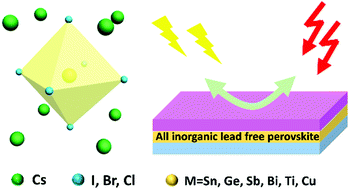当前位置:
X-MOL 学术
›
Mater. Chem. Front.
›
论文详情
Our official English website, www.x-mol.net, welcomes your
feedback! (Note: you will need to create a separate account there.)
All-inorganic lead-free perovskites for optoelectronic applications
Materials Chemistry Frontiers ( IF 6.0 ) Pub Date : 2019-01-28 00:00:00 , DOI: 10.1039/c8qm00611c Xingtao Wang 1, 2, 3, 4 , Taiyang Zhang 1, 2, 3, 4 , Yongbing Lou 4, 5, 6, 7 , Yixin Zhao 1, 2, 3, 4
Materials Chemistry Frontiers ( IF 6.0 ) Pub Date : 2019-01-28 00:00:00 , DOI: 10.1039/c8qm00611c Xingtao Wang 1, 2, 3, 4 , Taiyang Zhang 1, 2, 3, 4 , Yongbing Lou 4, 5, 6, 7 , Yixin Zhao 1, 2, 3, 4
Affiliation

|
Organic and inorganic hybrid lead halide perovskites have successfully emerged as revolutionary optoelectronic semiconductors for use in various applications. The long-term stability and lead toxicity of hybrid lead halide perovskites have attracted increased attention; therefore, all-inorganic lead-free perovskites have become an alternative perovskite for use in optoelectronic applications. Among them, all-inorganic CsSnI3 has also been developed. The main issue limiting the optoelectronic performance and stability of Sn-based perovskites is the low chemical stability of Sn2+, which is very easy to be oxidized to Sn4+ under air conditions. Several approaches have been adopted to prevent the oxidation of Sn, thereby improving its performance. However, its chemical stability is still difficult to manage. Other than Sn, other transition metals such as Ge, Bi, and Cu have also been used to substitute Pb and form novel lead-free perovskites. Although such non-Sn lead-free perovskites exhibit much better stability, their photovoltaic performances are lower as compared to those of Pb- or Sn-based perovskites. However, these novel all-inorganic lead-free perovskites exhibit potential in photoluminescence and other optoelectronic applications. Overall, we have reviewed the recent progresses and outlooks regarding the prospects and challenges faced by all-inorganic lead-free perovskites.
中文翻译:

用于光电应用的全无机无铅钙钛矿
有机和无机杂化卤化铅钙钛矿已成功出现,成为革命性的光电半导体,可用于各种应用。杂化卤化铅钙钛矿的长期稳定性和铅毒性已引起越来越多的关注。因此,全无机无铅钙钛矿已成为光电应用中的替代钙钛矿。其中,还开发了全无机CsSnI 3。限制Sn基钙钛矿光电性能和稳定性的主要问题是Sn 2+的化学稳定性低,它很容易被氧化成Sn 4+在空气条件下。已经采取了几种方法来防止Sn的氧化,从而提高其性能。但是,其化学稳定性仍然难以管理。除锡以外,其他过渡金属(如Ge,Bi和Cu)也已被用来替代Pb并形成新型的无铅钙钛矿。尽管此类非Sn的无铅钙钛矿具有更好的稳定性,但与Pb或Sn基钙钛矿相比,其光伏性能却较低。然而,这些新颖的全无机无铅钙钛矿在光致发光和其他光电应用中具有潜力。总体而言,我们回顾了有关全无机无铅钙钛矿面临的前景和挑战的最新进展和前景。
更新日期:2019-01-28
中文翻译:

用于光电应用的全无机无铅钙钛矿
有机和无机杂化卤化铅钙钛矿已成功出现,成为革命性的光电半导体,可用于各种应用。杂化卤化铅钙钛矿的长期稳定性和铅毒性已引起越来越多的关注。因此,全无机无铅钙钛矿已成为光电应用中的替代钙钛矿。其中,还开发了全无机CsSnI 3。限制Sn基钙钛矿光电性能和稳定性的主要问题是Sn 2+的化学稳定性低,它很容易被氧化成Sn 4+在空气条件下。已经采取了几种方法来防止Sn的氧化,从而提高其性能。但是,其化学稳定性仍然难以管理。除锡以外,其他过渡金属(如Ge,Bi和Cu)也已被用来替代Pb并形成新型的无铅钙钛矿。尽管此类非Sn的无铅钙钛矿具有更好的稳定性,但与Pb或Sn基钙钛矿相比,其光伏性能却较低。然而,这些新颖的全无机无铅钙钛矿在光致发光和其他光电应用中具有潜力。总体而言,我们回顾了有关全无机无铅钙钛矿面临的前景和挑战的最新进展和前景。


















































 京公网安备 11010802027423号
京公网安备 11010802027423号